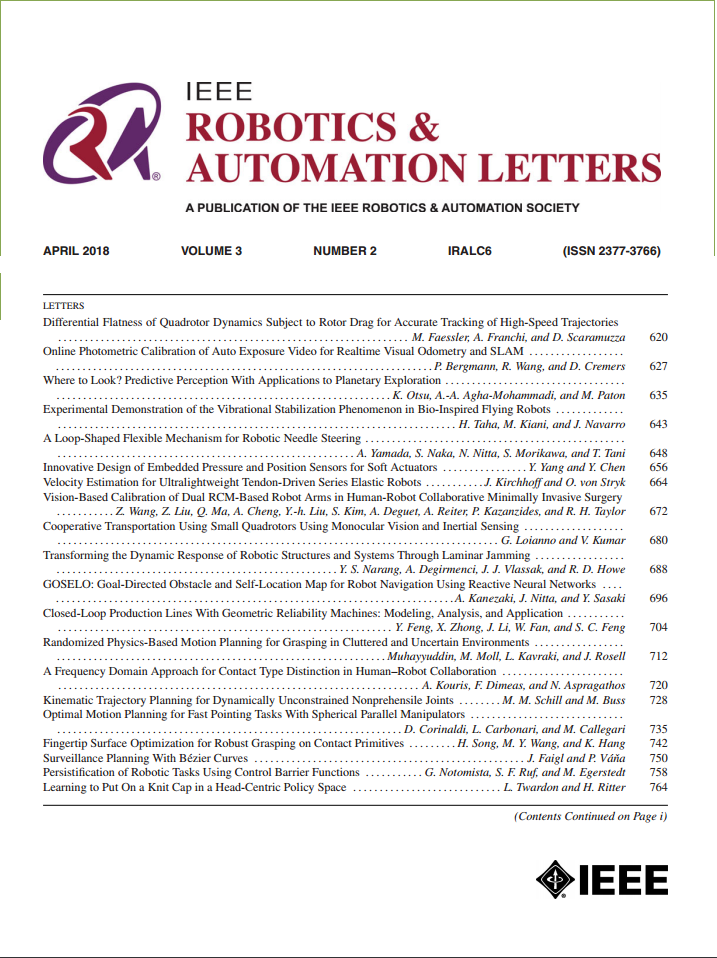The Foldable Fin With Dynamic Adjustments for Manta Ray-Inspired Robots
IF 4.6
2区 计算机科学
Q2 ROBOTICS
引用次数: 0
Abstract
Biological manta rays alter the projected area of their pectoral fins during flapping, achieve different flapping strokes to adjust dynamic generation, such as holding, rising, sinking and rolling strokes. Manta ray-inspired robots possess high motion efficiency and stability, exhibiting broad prospects in underwater applications. A manta ray-inspired robot capable of projected area variations can gain more agility to adapt to complex environments. However, the fin structures of existing manta ray-inspired robots primarily serve to support and drive the flexible skin to flap, lacking the ability to vary the projected area. To achieve diverse flapping strokes, robots typically rely on multiple servos and complex algorithms to adjust each servo’s motion parameters. In this article, we propose a foldable fin for manta ray-inspired robots, structurally varies the robot's span to adjust dynamic generation under simple control. The foldable fin is designed by linkage mechanisms, where three foldable modules are modularly meshed through tooth profiles, enabling synchronized folding and extending along a carbon spar. These design achieve a weight of 95 g with high stiffness, and a蝠鲼启发机器人的可折叠鳍与动态调整
生物蝠鲼在拍动过程中改变胸鳍的投影面积,实现不同的拍动行程来调节动力的产生,如持、升、沉、滚动等。蝠鲼机器人具有运动效率高、稳定性好等特点,在水下应用前景广阔。受蝠鲼启发的机器人能够预测区域变化,从而获得更大的灵活性,以适应复杂的环境。然而,现有的受蝠鲼启发的机器人的鳍结构主要用于支持和驱动灵活的皮肤拍打,缺乏改变投影面积的能力。为了实现不同的扑动行程,机器人通常依赖于多个伺服器和复杂的算法来调整每个伺服器的运动参数。在本文中,我们提出了一种用于蝠鲼机器人的可折叠鳍,在简单的控制下,从结构上改变机器人的跨度来调节动力产生。可折叠鳍由连杆机构设计,其中三个可折叠模块通过齿形模块化啮合,实现同步折叠和沿碳梁延伸。这些设计实现了95克的重量和高刚度,以及78.75%的可折叠率和快速操作。建立了可折叠鳍的运动学模型,以描述不同的行程。水下试验表明,在对称冲程下,可折叠鳍的最大长度比其最小长度在升力和推力方面有显著增加,而在非对称冲程下,可折叠鳍的动力方面有显著调整。游泳验证进一步证实了可折叠鳍的推进能力,突出了其提高蝠鲼机器人敏捷性的潜力。
本文章由计算机程序翻译,如有差异,请以英文原文为准。
求助全文
约1分钟内获得全文
求助全文
来源期刊

IEEE Robotics and Automation Letters
Computer Science-Computer Science Applications
CiteScore
9.60
自引率
15.40%
发文量
1428
期刊介绍:
The scope of this journal is to publish peer-reviewed articles that provide a timely and concise account of innovative research ideas and application results, reporting significant theoretical findings and application case studies in areas of robotics and automation.
 求助内容:
求助内容: 应助结果提醒方式:
应助结果提醒方式:


